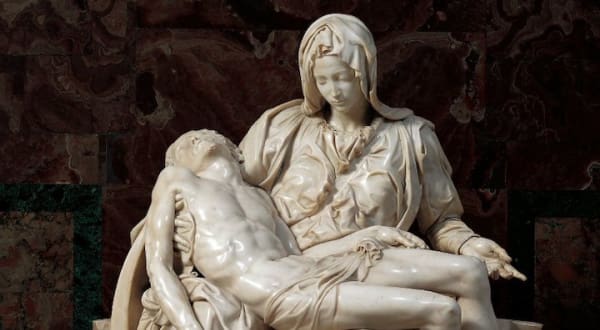They say that Michelangelo saw the figures he sculpted within the rough blocks of marble. His work as a sculptor consisted in freeing the artwork from the stone and allowing the image to emerge. In near-perfect correspondence to the archetype in Michelangelo’s mind, his image of Our Lady of the Pietà, sorrowful, silent, and lovingly abandoned to Our Lord’s Passion, radiates the power of a masterpiece.
And so too with the living images crafted by the Divine Artist.
The Lord sees within each of us His hope for the perfect fulfillment of all He has created us to be. For every human being, there is a divine archetype within God’s heart. We become, to a greater or lesser extent, the person He has called us to become, and when we correspond most closely to His perfect ideal for our lives, we too become a masterpiece.
And yet there is a difference. God, the Divine Artist, does not work on inanimate material. We are not a block of marble or a lump of lifeless clay. Our Lord has infused us with His Holy Spirit, and given us the freedom to correspond – or not– to His artistic strokes. The loving genius of our Divine Artist is that He works on living, breathing, free-willed material.
St. Edith Stein addresses this collaboration between the Divine Artist and His living artwork in her spiritual poem “I Am Always in Your Midst”:
The eternal Artist. . .does not work on dead material;
His greatest creative joy in fact is
That under his hand the image stirs,
That life pours forth to meet him.
The life that he himself has placed within it
And that now answers him from within
To chisel blows or quiet finger stroke.
So we collaborate with God on his work of art.
Chisel blows or quiet finger stroke. We know the moments when the Master Craftsman has fashioned us with His hammer. We have felt the jarring, absolute nature of the blows. How often we turned aside to avoid His precise and perfect aim. And then, the finger strokes. The fine detail work added imperceptibly with His smallest, gentlest brush.
The outcome of such collaboration is the splendor of the human soul drawn near to divine beauty by grace, living images that declare the Divine Love to which they have responded, surpassing even the most stunning material artwork. And we all know when we have encountered such a masterpiece.
The living images she encountered throughout her conversion called St. Edith Stein to reflect upon their origin. In Frankfurt, intending to visit the museums and cathedral, Stein instead found herself transfixed by a woman who simply knelt to pray. “We stopped in at the cathedral for a few minutes; and, while we looked around in respectful silence, a woman carrying a market basket came in and knelt down in one of the pews to pray briefly. This was something entirely new to me. . . .I could never forget that.”
This modest woman would never know the profound impact that her act of daily faith had upon a great philosophical mind, searching for truth. It was not a theological argument that convinced Stein of Christ’s personhood, but the conversation she witnessed between a housewife and her Lord.
Fittingly, Stein herself becomes a living image, in her willingness to suffer martyrdom in the death camp at Auschwitz. During her final hours, Stein comforted the children whose mothers were too distraught to care for them properly. In her acts of love and mercy, in fact, she was said to have resembled “a living Pietà,” carrying these suffering children in her arms in the place of Christ, witnessing fully her faith in the Lord to whom she had abandoned her life.
Our Lady Herself, so profoundly wedded to the Holy Spirit, lived as the masterpiece of the Lord’s Most Sacred Will at every moment of her life. Her Heart was always one with the Divine Heart. Under her Immaculate Heart, the Divine Heart took the flesh of a human heart. Thus, wherever Our Lady was, there the Lord’s perfect will for her life was made manifest. Her faithful, believing surrender draws our hearts to the Heart of her Divine Son, disposing us, in turn, to embrace, with total trust, the Father’s best and holiest plan of Love.
The power of such a masterpiece demands a fitting response. We cannot pause at the museum glass, admire the image, and continue on our way. We must be changed interiorly. “There will scarcely be a believing artist,” Stein notes, “who has not felt compelled to portray Christ on the cross or carrying the cross. But the Crucified One demands from the artist more than a mere portrayal of the image. He demands that the artist, just as every other person, follow Him: that he both make himself and allow himself to be made into an image of the one who carries the cross and is crucified.”
When we re-create within our own lives the truth and beauty that the image has revealed, we reflect anew the splendid majesty of Our Lord’s magnificent artistry. Christ Himself has shown the way. Offering Himself to the hammer blows of the Roman guard on the Mount of Calvary, His immolation becomes our Redemption. The centurion’s spear pierces His side, from which blood and water flow as a sign of the purification and life of His glorious, pierced Heart, ever ready to receive us.
Through Him we see the perfect way. With Him, we respond to His call, adoring and praising and corresponding to the grace of His Holy Cross, the masterpiece of love by which He has redeemed the world.
*Image: Pietà by Michelangelo Buonarroti, 1498–1499 [St. Peter’s Basilica, Vatican City]
This column first appeared at The Catholic Thing (www.thecatholicthing.org). Copyright 2021. All rights reserved. Reprinted with permission.





